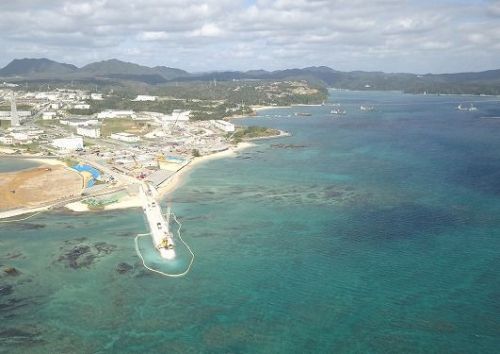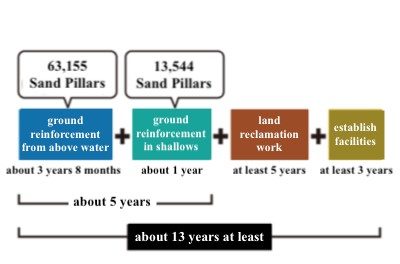FRF construction to take at least 13 years, subsequent land subsidence may incur lasting costs

Land reclamation work continues on the shore in Henoko, Nago City, on February 23; to the right is Oura Bay where the soft seafloor has been discovered. [Photograph taken via small drone]
March 10, 2019 Ryukyu Shimpo
By Manato Akira and Sumire Shimaoka
Facts demonstrating that the issue of soft ground in Oura Bay will lengthen the construction period of the Futenma Replacement Facility (FRF) in Henoko, Nago City, have been coming to light one after another.
The Japanese government predicts that ground reinforcement alone will take about five years’ time, yet the Okinawa Prefectural Government (OPG) will not approve the application for the revised construction plan necessary to carry out this ground reinforcement.
Inflation of both the construction period and the construction cost is unavoidable, and so the government’s justification for advancing Henoko relocation, namely, “returning Futenma Air Station and removing the danger as soon as possible,” is crumbling.
Time projected in the Japanese government’s initial FRF plan was eight years total, five of which would be spent on land reclamation, and three of which would be used for establishing facilities.
However, upon simple calculation it has been found that dealing with the soft ground will expand the timeframe to more than thirteen years.
The OPG independently made a preliminary calculation, which was in agreement with the central government’s calculation of “thirteen years.”
Revised Construction Plan
According to the work schedule in a report issued by the Ministry of Defense (MOD), ground reinforcement is extensive and has been separated into two phases.
It is estimated that one phase will take approximately three years and eight months’ time, and 63,155 sand pillars driven into the soft ground from large work ships on the water, to strengthen the ground.
Additionally, the second phase involves a section of shallows where ground reinforcement is necessary, but in which a large ship cannot operate.
Once land reclamation is completed the MOD plans to drive in 13,544 sand pillars into this section.
This process should take about one year. Both phases together should take approximately five years.
There is mention of the section of shallows in the MOD report, which specifies that ground reinforcement from on the ocean is to take place before reinforcement in the shallow section.
It is anticipated that these two ground improvement operations will not take place simultaneously.
The Japanese government will apply to the OPG for approval of the revised construction plan.
These ground improvement operations can start after the application is approved.
Okinawans once again demonstrated their opposition to the Henoko base in the February prefectural referendum.
The MOD assessed, “The governor cannot exactly put his stamp [of approval] on the revised plan.”
If ground reinforcement work cannot start, construction of the FRF will fall behind schedule.
77,000 sand pillars
In the MOD report there was mention of the Tokyo International Airport (Haneda Airport) as a comparative example to the ground improvement work in Henoko, which will require approximately 77,000 sand pillars.
Even at the opening of deliberations in the National Diet, the MOD explained that the ground improvement work in Henoko is feasible, and emphasized that the number of sand pillars are “few.” It cited past ground reinforcement examples, including approximately 250,000 pillars used at Haneda Airport, about 1.03 million pillars used one time at Kansai Airport, and approximately 1.20 more pillars used on a second occasion at Kansai Airport.
Associate Professor Shoji Kamao of Nihon University, who specializes in geotechnology, refutes: “The scale of the land reclamation area at Haneda Airport was different, so naturally the number of pillars differs.
It is not an issue of the number of pillars but of their depth; the deeper the pillars go the more difficult construction becomes.”
At its deepest point, the place where ground reinforcement work is needed in Henoko reaches a depth of 90 meters below sea level.
However, the MOD claims that ground reinforcement is only necessary to a depth of 70 meters, because below that point is a firm layer of clay and reinforcement there is unnecessary.
Nonetheless, the Kansai Airport example does not have as deep a ground reinforcement site as Henoko, and even now 10 centimeters of ground subsidence occurs each year and is immensely costly to repair.
The MOD has given consideration to countermeasures should land subsidence occur after completion of the project in Henoko, and it is possible that it may require additional costs for repair.
Professor Kamao warned, “It is projected that land subsidence will occur long-term, so if appropriate countermeasures are not taken the structure will become unsafe.”
(English translation by T&CT and Erin Jones)
Previous Article:Mamiko Higa hits a life-saving birdie on the 17th hole to win the Daikin Orchid Ladies Golf Tournament
Next Article:Fujian Province presents Okinawa with lion statues to celebrate their friendship
[Similar Articles]
- Central government considers Henoko seafloor reinforcement method using 60,000 sand pillars
- Ground reinforcement means initial sand needs for FRF increase 11-fold, cost rises to 150 billion yen
- Expert claims no previous reinforcement of soft ground 90 meters below sea level, the depth found in Henoko construction area
- Soft seafloor precludes marine work yards for temporary caisson storage in FRF construction
- How far will costs rise? 147.1 billion yen already spent on mere 1% of Henoko land reclamation, prefectural government estimates total of 2.55 trillion
 Webcam(Kokusai Street)
Webcam(Kokusai Street)


